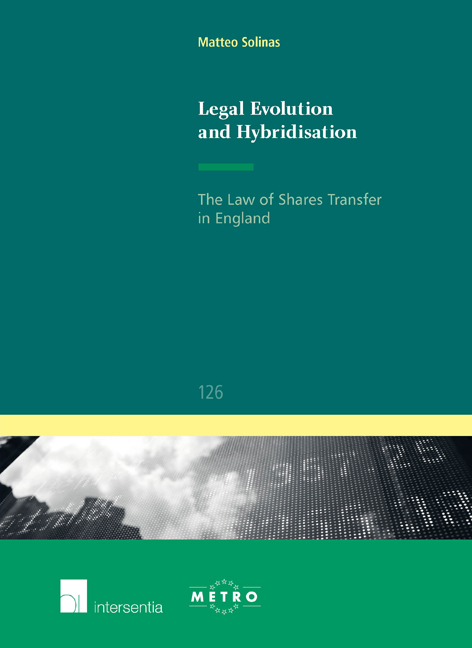Book contents
- Frontmatter
- Foreword
- Preface
- Acknowledgements
- Contents
- Table of Cases
- Introduction
- PART I THE IDEA OF HYBRIDITY IN COMPARATIVE LAW
- Chapter 1 The Debate on the Diffusion of Law
- Chapter 2 The Leitmotif of the Book
- Chapter 3 Hybridisation and Legal Reception
- Summary of Part I
- PART II THE CIRCULATION OF SHARES
- PART III THE TRANSFER OF (INTERESTS IN) SHARES
- Summary of Part III
- Conclusions
- Bibliography
- IUS COMMUNE EUROPAEUM
Summary of Part I
from PART I - THE IDEA OF HYBRIDITY IN COMPARATIVE LAW
Published online by Cambridge University Press: 22 November 2017
- Frontmatter
- Foreword
- Preface
- Acknowledgements
- Contents
- Table of Cases
- Introduction
- PART I THE IDEA OF HYBRIDITY IN COMPARATIVE LAW
- Chapter 1 The Debate on the Diffusion of Law
- Chapter 2 The Leitmotif of the Book
- Chapter 3 Hybridisation and Legal Reception
- Summary of Part I
- PART II THE CIRCULATION OF SHARES
- PART III THE TRANSFER OF (INTERESTS IN) SHARES
- Summary of Part III
- Conclusions
- Bibliography
- IUS COMMUNE EUROPAEUM
Summary
Part I outlined the raison d’ être of this study. It addressed the significance of the concept of hybridity within the comparative debate on legal change. In doing so, it examined the theory that describes the movement of law from one country to another by using the metaphor of legal transplant. Two irreconcilable approaches were discussed. The first one suggested that the evolution of law is largely autonomous from society as it consists primarily of a function of rules being imported from another legal system. The second one established that the development of law cannot take place through borrowing because law mirrors, and is responsive to, situated linguistic, cultural and moral national frameworks. Both views were found to fall short: the first one ignores the relationship between legal comparison and sociology of law, and the second one over-simplifies the concepts of language and culture.
Chapter 1 offered a proposal to tackle the comparative conundrum. The inquiry opened with the observation that borrowing is not necessarily a legal phenomenon, but that it reflects a common trend of social life, a mechanism of culture diffusion. It applies to law because law is itself a form of culture. Building on this, it was, however, noted that the fact of borrowing per se has a mere descriptive value and says little about culture interaction and the assimilation process.
For this reason, Chapter 2 considered recent contributions on culture contact and culture change and concluded that they provide an interesting explanation for the process of borrowing and legal evolution. The analysis centred on the notion of hybridity, a fundamental theme in cultural and post colonialist studies that highlights the ‘in-betweenness’ of people and their actions in colonial situations. By complying with colonial norms and standards and at the same time maintaining the indigenous perceptions, colonial people develop new cultural norms and standards of their own. They create new traditions. The process of hybridisation was illustrated by reference to cases taken from archaeological studies. It was argued that the same dynamics can be used to explain the reception mechanism in law. As with colonial norms and standards, legal paradigms borrowed outside their original meanings become unsettled.
- Type
- Chapter
- Information
- Legal Evolution and Hybridisation , pp. 45 - 46Publisher: IntersentiaPrint publication year: 2014



